Punjab State Board PSEB 11th Class Maths Book Solutions Chapter 9 Sequences and Series Miscellaneous Exercise Questions and Answers.
PSEB Solutions for Class 11 Maths Chapter 9 Sequences and Series Miscellaneous Exercise
Question 1.
Show that the sum of (m + n)th and (m – n)th terms of an A.P. is equal to twice the mth term.
Answer.
Let a be the first term and d the common difference of an A.P.
Now, we want to prove that
Tm + n + Tm – n = 2Tm
L.H.S.= Tm + n + Tm – n
= [a + (m + n – 1) d] + [a + (m – n – 1)d]
= 2a + (m + n -1 + m – n – 1) d
= 2a + (2m – 2) d
= 2 (a + (m – 1) d]
= 2Tm R.H.S.
Hence proved.
Question 2.
If the sum of three numbers in AP is 24 and their product is 440, find the numbers.
Answer.
Let the three numbers in A.P. be a – d, a, and a + d.
According to the given information,
(a – d) + (a) + (a + d) = 24
3a = 24
⇒ a = 8
and (a – d) a (a + d) = 440 ………………(ii)
(8 – d) (8) (8 + d) = 440
(8 – d) (8 + d) = 55
= 64 – d2 = 55
d2 = 64 – 55 = 9
d = ±3
Therefore, when d = 3, the numbers are 5, 8 and 11 and when d = – 3, the numbers are 11, 8 and 5.
Thus, the three numbers are 5, 8 and 11.
![]()
Question 3.
Let the sum of n, 2n, 3n terms of an A.P. be S1, S2 and S3, respectively, show that S3 = 3 (S2 – S1).
Answer.
Let a be the first term and d common difference of an A.P. Therefore
S1 = \(\frac{n}{2}\) [2a + (n – 1) d] ……………(i)
S2 = \(\frac{2 n}{2}\) [2a + (2n – 1) d] ………………(ii)
S3 = \(\frac{3 n}{2}\) [2a + (3n – 1) d] ……………….(iii)
Now from eq.s (i) and (ii) we have
S2 – S1 = \(\frac{2 n}{2}\) [2a + (2n – 1) d] – \(\frac{n}{2}\) [2a + (n – 1) d]
= \(\frac{n}{2}\) [4a + (4n – 2) d] – \(\frac{n}{2}\) [2a + (n – 1) d]
= \(\frac{n}{2}\) [4a + (4n – 2) d – 2a – (n – 1) d]
= \(\frac{n}{2}\) [2a + (3n – 1) d]
∴ 3 (S2 – S1) = \(\frac{3 n}{2}\) [2a + (3n – 1) d] = S3
Hence, S3 = 3 (S2 – S1)
Question 4.
Find the sum of all numbers between 200 and 400 which are divisible by 7.
Answer.
The number which are divisible by 7 between 200 and 400 are 203, 210, 217, ……………, 399.
Clearly, they form an A.P.
a = 203, d = 7 and Tn = 399
Tn = a + (n – 1) d
399 = 203 + (n – 1) 7
(n – 1) 7 = 399 – 203
(n – 1) 7 = 196
⇒ n – 1 = \(\frac{196}{7}\)
n – 1 = 28
⇒ n = 28 + 1
n = 29
Sn = \(\frac{n}{2}\) [2a + (n – 1) d]
S29 = \(\frac{29}{2}\) [2 × 203 + (29 – 1) 7]
= \(\frac{29}{2}\) [406 + 28 × 7]
= \(\frac{29}{2}\) [406 + 196]
= \(\frac{29}{2}\) × 602 2 2 2
= 29 × 301 = 8729.
![]()
Question 5.
Find the sum of integers from 1 to 100 that are divisible by 2 or 5.
Answer.
The numbers from 1 to 100 which are divisible by 2 are 2, 4, 6, 8, …………, 100.
Clearly, they are in A.P., where a = 2 and d = 4 – 2 = 2
Tn = a + (n – 1) d
⇒ 100 = 2 + (n – 1)2
⇒ 100 – 2 = (n – 1)2
⇒ 98 = (n – 1)2
⇒ 49 = n – 1
n = 50
Therefore, sum of 50 numbers,
S50 = \(\frac{50}{2}\) [2 × 2 + (50 – 1)2]
= 25 [4 + 49 × 2]
= 25 [4 + 98]
= 25 × 102
S50 = 2250
Now, the numbers from 1 to loo which are divisible by 5 are 5, 10, 15, 20, 100.
Clearly, they are in A.P., where a = 5 and d = 10 – 5 = 5
Tn = a + (n – 1) d
100 = 5 + (n – 1) 5
⇒ 100 – 5 = (n – 1) 5
⇒ (n – 1) = \(\frac{95}{5}\)
n – 1 = 19
⇒ n = 19 + 1 = 20
Now, Sn = \(\frac{n}{2}\) [2a + (n – 1) d]
S20 = \(\frac{20}{2}\) [2 × 5 + (20 – 1) 5]
= 10[10 + 19 × 5]
= 10 [10 + 95]
=10 (105)
S20 = 1050 …(ii)
Now, the numbers from 1 to 100 which are divisible by 10 are 10, 20, 30, … 100.
Clearly, they are in A.P., where a = 10,
d = 20 – 10 = 10 and n = 10
Sn = [2a + (n – 1) d]
S10 = \(\frac{10}{2}\) [2 × 10 + (10 – 1) 10]
= 5[20 + 9 × 10]
= 5[20 + 90]
= 5 × 110 = 550 …………….(iii)
Hence, required sum of integers from 1 to 100 which are divisible by 2
or 5 = 2550 + 1050 – 550 [using eqs. (i), (ii) and (iii)]
= 3600 – 550 = 3050.
![]()
Question 6.
Find the sum of all two digit numbers which when divided by 4, yields 1 as remninder.
Answer.
The sum of two digit numbers divisible by 4 yield 1 as remainder is 13 + 17 + 21 + ………… + 97.
Let the sum be denoted by S and let 97 be the nth term.
∴ Tn = a + (n – 1) d
97 = a + (n – 1) d
= 13 + (n – 1) 4
⇒ 97 = 13 + 4n – 4
⇒ 97 – 9 = 4n
⇒ n = 22
∴ The sum, Sn = 13 + 17 + 21 + ………….+ 97
∴ Sn = \(\frac{n}{2}\) [2a + (n – 1)d]
= \(\frac{22}{7}\) [2 × 13 + (22 – 1) × 4]
= 11 [26 + 21 × 4]
= 11 [26 + 84]
= 11 × 110 = 1210
Question 7.
If f is a function satisfying f(x + y) = f(x) f(y) for all x, y ∈ N such that f(1) = 3 and f(x) = 120, fInd the value of n.
Answer.
It is given that,
f(x + y) = f(x) × f(y) for all x, y ∈ N
f(1) = 3
Taking x = y = 1 in eq. (i), we obtain
f(1 + 1) = f(2) = f(1)
f(1) = 3 × 3 = 9
Similarly, f(1 + 1 + 1) = f(3) = f(1 + 2) = f(1) f(2) = 3 × 9 = 27
f(4) = f(1 + 3) = f(1) f(3) = 3 × 27 = 81
f(1), f(2), f(3) , that is 3, 9, 27, …………, forms a G.P. with both the first term and common ratio equal to 3.
It is known that, Sn = \(\frac{a\left(r^{n}-1\right)}{r-1}\)
It is given that, \(\sum_{x=1}^{n}\) f(x) = 120
∴ 120 = \(\frac{3\left(3^{n}-1\right)}{3-1}\)
⇒ 120 = \(\frac{3}{2}\) (3n – 1)
⇒ 3n – 1 = 80
⇒ 3n = 81 = 3
∴ n = 4
Thus, the value of n is 4.
![]()
Question 8.
The sum of some terms of G.P. is 315 whose first term and the common ratio are 5 and 2, respectively. Find the last term and the number of terms.
Answer.
Let the sum of n terms of the G.P. be 315.
It is known that, Sn = \(\frac{a\left(r^{n}-1\right)}{r-1}\)
It is given that the first term a is 5 and common ratio r is 2.
315 = \(\frac{5\left(2^{n}-1\right)}{2-1}\)
⇒ 2n = 64 = (2)6
⇒ n = 6
∴ Last term of the G.P.= 6th term
= ar6 – 1 = (5) (2)5 = (5) (32) = 160
Thus, the last term of the G.P. is 160.
Question 9.
The first term of a G.P. is 1. The sum of the third term and fifth term is 90. Find the common ratio of G.P.
Answer.
Let a and r be the first term and the common ratio of the G.P. respectively.
a = 1
a3 = ar2 = r2
a5 = ar4 = r4
According to the question,
r2 + r4 = 90
r4 + r2 – 90 = 0
r2 = \(\frac{-1 \pm \sqrt{1+360}}{2}\)
= \(\frac{-1 \pm \sqrt{361}}{2}=\frac{-1 \pm 19}{2}\)
= – 10 or 9
∴ r = ± 3 (Taking real roots)
Thus, the common ratio of the G.P. is ± 3.
![]()
Question 10.
The sum of three numbers in G.P. is 56. If we subtract 1, 7, 21 from these numbers in that order, we obtain an arithmetic progression. Find the numbers.
Answer.
Let the three numbers in G.P. be a, ar and ar2.
From the given condition, a + ar + ar2 = 56
a (1 + r + r2) = 56
a = \(\frac{56}{1+r+r^{2}}\) …………………(i)
a – 1, ar – 7, ar2 – 21 forms an A.P.
∴ (ar – 7) – (a – 1) = (ar2 – 21) – (ar – 7)
⇒ ar – a – 6 = ar2 – ar – 14
⇒ ar2 – 2ar + a = 8
⇒ ar2 – ar – ar + a = 8
a(r2 + 1 – 2r) = 8
a(r – 1)2 = 8 ………….(ii)
\(\frac{56}{1+r+r^{2}}\) (r – 1)2 = 8 [using eq. (1)]
⇒ 7 (r2 – 2r + 1) = 1 + r + r2
⇒ 7r2 – 14r + 7 – 1 – r – r2 = 0
⇒ 6r2 – 15r + 6 = 0
⇒ r2 – 12r – 3r + 6 = 0
⇒ 6r (r – 2) – 3 (r – 2) = 0
⇒ (6r – 3)(r – 2) = 0
∴ r = 2, \(\frac{1}{2}\)
When r = 2, a = 8; When r = \(\frac{1}{2}\), a = 32
Therefore, when r = 2, the three numbers in G.P. are 8, 16 and 32.
When r = \(\frac{1}{2}\), the three numbers in G.P. are 32, 16 and 8.
Thus, in either case, the three required numbers are 8, 16, and 32.
![]()
Question 11.
A G.P. consists of an even number of terms. If the sum of all the terms is 5 times the sum of terms occupying odd places, then find its common ratio.
Answer.
Let the G.P. be T1, T2, T3, T4, …………….T2n
Number of terms = 2n
According to the given condition,
T1 + T2 + T3 + ………….. + T2n = 5 [T1 + T3 + ……………. + T2n – 1]
⇒ T1 + T2 + T3 + ………….. + T2n – 5 [T1 + T3 + …………… + T2n – 1] = o
⇒ T2 + T4 + ………….. + T2n = 4 [T1 + T3 + ………… + T2n – 1]
Let the G.P. be a, ar, ar2, ar3 ………..
∴ \(\frac{\ {ar}\left(r^{n}-1\right)}{r-1}\) = \(\frac{4 \times a\left(r^{n}-1\right)}{r-1}\)
⇒ ar = 4a
r = 4
Thus, the common ratio of the G.P. is 4.
Question 12.
The sum of the first four terms of an A.P. is 56. The sum of the last four terms is 112. If its first term is 11, then find the number of terms.
Answer.
Let the A.P. be a, a + d, a + 2d, a + 3d,… a + (n – 2) d, a + (n – 1 )d
Sum of first four terms = a + (a + d) + (a + 2d) + (a + 3d) = 4a + 6d
Sum of last four terms = [a + (n – 4) d] + [a +(n – 3) d] + [a + (n – 2) d] + [(a + n – 1) d]
= 4a + (4n – 10)d
According to the given condition,
4a + 6d = 56
⇒ 4 (11) + 6d = 56 [Since a = 11 (given)]
⇒ 6d = 12
⇒ d = 2
4a + (4n – 10) d = 112
⇒ 4(11) + (4n – 10) 2 = 112
⇒ (4n – 10)2 = 68
⇒ 4n – 10 = 34
4n = 44
n = 11
Thus, the number of terms of the A.P. is 11.
![]()
Question 13.
If \(\frac{a+b x}{a-b x}=\frac{b+c x}{b-c x}=\frac{c+d x}{c-d x}\), then show that a, b, c and d are in G.P.
Answer.
It is given that \(\frac{a+b x}{a-b x}=\frac{b+c x}{b-c x}\)
⇒ (a + bx) (b – cx) = (b + cx) (a – bx)
⇒ ab – acx + b2 x – bcx2 = ab – b2x + acx – bcx2
⇒ 2b2x = 2acx
⇒ b2 = ac
\(\frac{b}{a}=\frac{c}{b}\) ……………….(i)
Also, \(\frac{b+c x}{b-c x}=\frac{c+d x}{c-d x}\)
⇒ (b + cx) (c – dx) = (b – cx) (c + dx)
⇒ bc – bdx + c2x – cdx2 = bc + bdx – c2x – cdx2
⇒ 2 c2x = 2 bdx
⇒ c2 = bd
⇒ \(\frac{c}{d}=\frac{d}{c}\) ………….. (ii)
From eqs. (i) and (ii), we obtain \(\frac{b}{a}=\frac{c}{b}=\frac{d}{c}\)
Thus, a, b, c and d are in G.P.
![]()
Question 14.
Let S be the sum, P the product and R the sum of reciprocal of n terms in a G.P. Prove that P2 Rn = Sn.
Answer.
Let the G.P. be a, ar, ar2, ar3, ………….., arn – 1
According to the given information,
S = \(\frac{a\left(r^{n}-1\right)}{r-1}\)
P = an r\(\frac{n(n-1)}{2}\)
[∵ Sum of n natural numbers is n \(\frac{(n+1)}{2}\)]
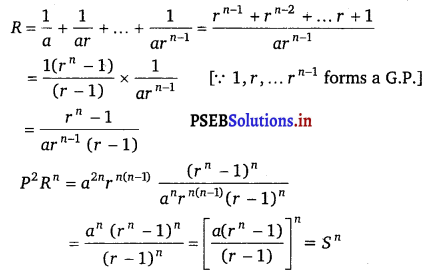
Hence P2 Rn = Sn.
Question 15.
The th, qth and rth terms of an AP. are a, b, c respectively. Show that(q – r)a + (r – p) b + (p – q) c = 0.
Answer.
Let A be the first term and d be the common difference.
Since, Tp = a
⇒ A + (p – 1) d = a ……………(i)
Tq = b
⇒ A + (q – 1) d = b …………….(ii)
and Tr = c
⇒ A + (r – 1) d = c ……………..(iii)
(i) On multiplying eq. (i) by (q – r), eq. (ii) by (r – p) and eq. (iii) by (p – q),we get
(q – r) A + (p – 1) (q – r) d = a (q – r) …………..(iv)
(r – p) A + (q – 1) (r – p) d = b (r – p) …………….(v)
and (p – q) A + (r – 1) (p – q) d = c (p – q) ……………(vi)
On adding eqs. (iv), (v) and eq. (vi), we get
(q – r) A + (p – 1) (q – r) d + (r – p) A + (q – 1) (r – p) d + (p – q) A + (r – 1) (p – q) d = a (q – r) + b (r – p) + c (p – q)
⇒ A [(q – r) + (r – p) + (p – q)] + (p – 1) (q – r) + (q – 1) (r – p) + (r – 1) (p – q)] d = a (q – r) + b (r – p) + c (p – q)
A(0) + (0)d = a (q – r) + b (r – p) + c (p – q)
a (q – r) + b (r – p) + c (p – q) = 0
Hence proved.
![]()
Question 16.
If \(a\left(\frac{1}{b}+\frac{1}{c}\right), b\left(\frac{1}{c}+\frac{1}{a}\right), c\left(\frac{1}{a}+\frac{1}{b}\right)\) are in A.P.,prove that a, b, c are in A.P.
Answer.
It is given that \(a\left(\frac{1}{b}+\frac{1}{c}\right), b\left(\frac{1}{c}+\frac{1}{a}\right), c\left(\frac{1}{a}+\frac{1}{b}\right)\) are in A.P.
∴ \(b\left(\frac{1}{c}+\frac{1}{a}\right)-a\left(\frac{1}{b}+\frac{1}{c}\right)=c\left(\frac{1}{a}+\frac{1}{b}\right)-b\left(\frac{1}{c}+\frac{1}{a}\right)\)
⇒ \(\frac{b(a+c)}{a c}-\frac{a(b+c)}{b c}=\frac{c(a+b)}{a b}-\frac{b(a+c)}{a c}\)
⇒ \(\frac{b^{2} a+b^{2} c-a^{2} b-a^{2} c}{a b c}=\frac{c^{2} a+c^{2} b-b^{2} a-b^{2} c}{a b c}\)
⇒ b2a – a2b + b2c – a2c = c2a – b2a + c2b – b2c
⇒ ab (b – a) + c (b2 – a2) = a (c2 – b2) + bc (c – b)
⇒ ab (b – a) + c (b – a) (b + a) = a (c – b) (c + b) + bc (c – b)
⇒ (b – a) (ab + cb + ca) = (c – b) (ac + ab + bc)
⇒ b – a = c – b
Thus, a, b and c are in A.P.
Question 17.
If a, b, c, d are in G.P. prove that (an + bn), (bn + cn), (cn + dn) are in G.P.
Answer.
It is given that a, b, c and d are in G.P.
∴ b2 = ac ……………(i)
c2 = bd …………….(ii)
ad = bc ……………..(iii)
It has to be proved that (an + bn), (bn + cn), (cn + dn) are in G.P.
i.e., (bn + cn)2 = (an + bn) (cn + dn)
Consider L.H.S.
(bn+ cn)2 = b2n + 2 bncn + c2n
= (b2)n + 2bncn + (c2)n
= (ac)n + 2bncn + (bd)n [using eqs. (i) and (ii)]
= ancn + bncn + bncn + bndn
= ancn + bncn + andn + bndn [using eq. (iii)]
= cn (an + bn) + dn (an + bn)
= (an + bn) (cn + dn) = R.H.S.
∴ (bn + cn)2 = (an + bn) (cn + dn)
Thus, (an + bn), (bn + cn), and (cn + dn) are in G.P.
![]()
Question 18.
If a and b are the roots of x2 – 3x + p = 0 and c, d are roots of x2 – 12x + q = 0, where a, b, c, d form a G.P. Prove that (q + p) : (q – p) = 17 : 15.
Answer.
a, b are the roots of x2 – 3x + p = 0
∴ a + b = 3, ab = p ……………. (i)
Again, c, d are the roots of xx2 – 12x + q = 0
∴ c + d = 12 and cd = q
Also, a, b, c, d are in G.P.
Let r be its common ratio.
∴ b = ar, c = ar2, d = ar3
Now a + b = a + ar = 3, [from eq. (i)]
and c + d = ar2 + ar3 = 12, [from eq. (ii)]
Dividing, we get
\(\frac{a(1+r)}{a r^{2}(1+r)}=\frac{3}{12}=\frac{1}{4}\)
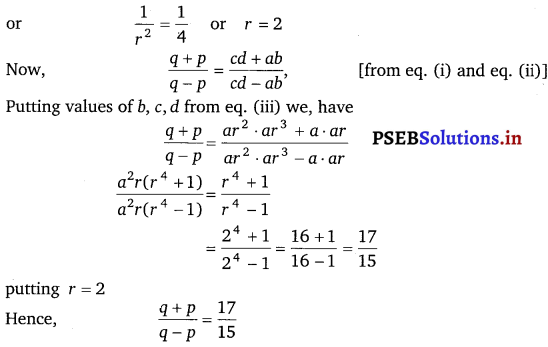
![]()
Question 19.
The ratio of the A.M. and G.M. of two positive numbers a and b, is m : n. Show that a : b (m + \(\sqrt{m^{2}-n^{2}}\)) : (m – \(\sqrt{m^{2}-n^{2}}\)).
Answer.
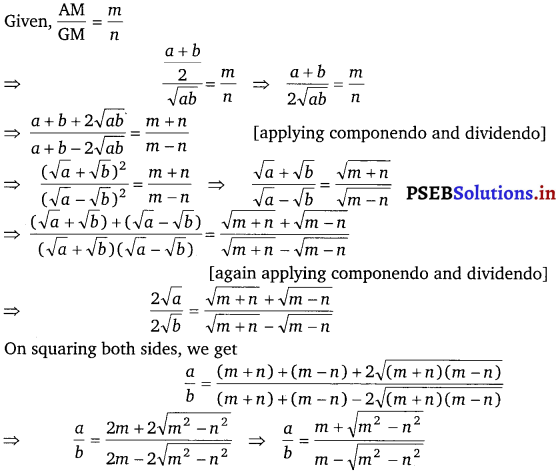
![]()
Question 20.
Ifa, b, c are in AP. a; b, c, d are in G.P. and \(\frac{1}{c}\), \(\frac{1}{d}\), \(\frac{1}{e}\) are in AP. prove that a, e, e are in GP.
Answer.
a, b, c are in A.P.
⇒ b = \(\frac{a+b}{2}\) ……………..(i)
b, c, d are in G.P.
⇒ c2 = bd
\(\frac{1}{c}\), \(\frac{1}{d}\), \(\frac{1}{e}\) are in A.P.
⇒ \(\frac{2}{d}=\frac{1}{c}+\frac{1}{e}\)
d = \(\frac{2 c e}{c+e}\)
Putting the value of b and d from eq. (i) and (iii) in eq.(ii), we get
c2 = \(\frac{a+c}{2} \cdot \frac{2 c e}{c+e}=\frac{c e(a+c)}{c+e}\)
c (c + e) = e (a + c)
c2 + ce = ae + ce
c2 = ae
∴ a, c, e are in G.P.
Question 21.
Find the sum of the following series up to n terms.
(i) 5 + 55 + 555 + ……………
(ii) .6 + .66 + .666 + ……………
Answer.
(i) We have, 5 + 55 + 555 + ……………… to n terms
= 5 (1 + 11 + 111 + ………… to n terms)
= \(\frac{5}{9}\) (9 + 99 +999 + ………… n terms)
[multiplying numerator and denominator by 9]
= \(\frac{5}{9}\) [(10 – 1) + (102 – 1) + (103 – 1) + ………….. (10n – 1)]
= \(\frac{5}{9}\) [(10 + 102 + 103 + …………… + 10n)] – (1 + 1 + …………. + 1) n terms]
= \(\frac{5}{9}\left[10\left(\frac{10^{n}-1}{10-1}\right)-n\right]\)
[∵ sum of G.P. = a \(\frac{\left(r^{n}-1\right)}{r-1}\)]
= \(\frac{5}{9}\left[\frac{10}{9}\left(10^{n}-1\right)-n\right]\)
= \(\frac{50}{81}\left(10^{n}-1\right)-\frac{5 n}{9}\)
![]()
(ii) We have 0.6 + 0.66 + 0.666 +… + to n terms
= 6 × 0.1 + 6 × 0.11 + 6 × 0.111 + ………………. + to n terms
= 6 [0.1 + 0.11 + 0.111 + ……………. + to n terms]
= \(\frac{6}{9}\) [0.9 + 0.99 + 0.999 + …………….. + to n terms]
[multiplying numerator and denominator by 9]
= \(\frac{2}{3}\left[\frac{9}{10}+\frac{99}{100}+\frac{999}{1000}+\ldots+\text { to } n \text { terms }\right]\)
= \(\frac{2}{3}\left[\left(1-\frac{1}{10}\right)+\left(1-\frac{1}{100}\right)+\left(1-\frac{1}{1000}\right)+\ldots \text { to } n \text { terms }\right]\)
= \(\frac{2}{3}\left[(1+1+1+\ldots n \text { terms })-\left(\frac{1}{10}+\frac{1}{10^{2}}+\frac{1}{10^{3}}+\ldots \text { to } n \text { terms }\right)\right.\)
= \(\frac{2}{3}\left[n-\frac{1}{10}\left\{\frac{1-\left(\frac{1}{10}\right)^{n}}{1-\frac{1}{10}}\right\}\right]\)
= \(\frac{2}{3}\left[n-\frac{1}{10}\left\{\frac{1-\left(\frac{1}{10}\right)^{n}}{\frac{9}{10}}\right\}\right]\)
[∵ sum of G.P. = a \(\frac{\left(1-r^{n}\right)}{(1-r)}\), |r| < 1]
= \(\frac{2}{3}\left[n-\frac{1}{9}\left\{1-\left(\frac{1}{10}\right)^{n}\right\}\right]\)
= \(\frac{2}{3}\) n – \(\frac{2}{27}\) (1 – 10– n).
![]()
Question 22.
Find the 20th term of the series 2 × 4 + 4 × 6 + 6 × 8 + ……………..+ n terms.
Answer.
The given series is 2 × 4 + 4 × 6 + 6 × 8 + …………….. n terms
∴ nth term = an = 2n × (2n + 2) = 4n2 + 4n
a20 = 4(20)2 + 4(20)
= 4 (400) + 80 = 1600 + 80 = 1680
Thus, the 20th term of the series is 1680.
Question 23.
Find the sum of the first n terms of the series : 3 + 7 + 13 + 21 + 31 + …………….
Answer.
Sn = 3 + 7 + 13 + 21 + 31 + ………… + Tn …………….(i)
Sn = 3 + 7 + 13 + … + Tn – 1 + Tn ……………(ii)
Then, eq. (i) – eq. (ii) given
0 = 3 + 4 + 6 + 8 + 10 + …………… to n terms Tn
Tn = 3 + (4 + 6 + 8 + 10 + …………….. to n – 1 terms )
3 + \(\frac{n-1}{2}\) [2 × 4 + (n – 1 – 1) 2]
= 3 + \(\frac{n-1}{2}\) [8 + 2n – 4]
= 3 + \(\frac{n-1}{2}\) [4 + 2n]
= 3 + (n – 1) (2 + n)
= 3 + n2 + n – 2
= n2 + n + 1
Sn = Σ (n2 + n + 1)
= Σn2 + Σn + 1 × n
= \(\frac{n(n+1)(2 n+1)}{6}+\frac{n(n+1)}{2}\) + n
= \(\frac{n}{6}\) [2 n2 + n + 2n + 1 + 3n + 3 + 6]
= \(\frac{n}{6}\) [2n2 + 6n + 10]
= \(\frac{n}{6}\) (n2 + 3n + 5).
![]()
Question 24.
If S1, S2, S3 are the sum of first n natural numbers, their squares and their cubes, respectively, show that 9S22 = S3 (1 + 8S1).
Answer.
S1 is sum of the first n natural numbers.
∴ S1 = Σn = \(\frac{n(n+1)}{2}\)
So is the sum of the cubes of first n natural numbers.
S2 = Σn2
= \(\frac{n(n+1)(2 n+1)}{6}\)
S3 is the sum of the cubes of first n natural numbers.
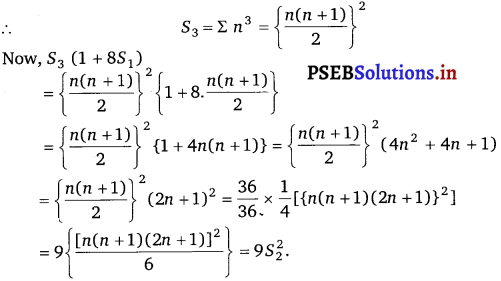
Question 25.
Find the sum of the following series up to n terms : \(\frac{1^{3}}{1}+\frac{1^{3}+2^{3}}{1+3}+\frac{1^{3}+2^{3}+3^{3}}{1+3+5}+\ldots\)
Answer.
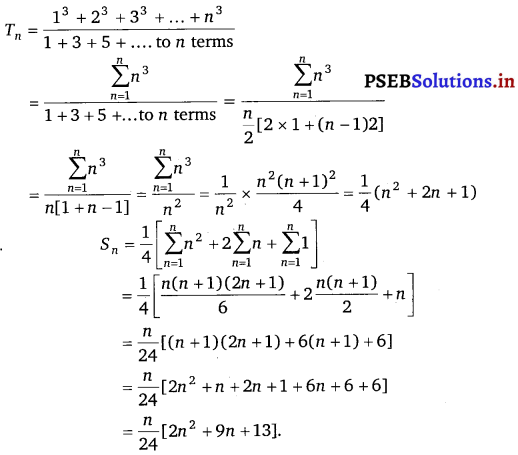
![]()
Question 26.
Show that \(\frac{1 \times 2^{2}+2 \times 3^{2}+\ldots+n \times(n+1)^{2}}{1^{2} \times 2+2^{2} \times 3+\ldots+n^{2} \times(n+1)}=\frac{3 n+5}{3 n+1}\).
Answer.
Let Tn and Tn be the nth terms of numerator and denominator respectively and Sn, S’n be the respective sums of their n terms.
We have,
L.H.S. = \(\frac{1 \cdot 2^{2}+2 \cdot 3^{2}+\ldots+n(n+1)^{2}}{1^{2} \cdot 2+2^{2} \cdot 3+\ldots+n^{2}(n+1)}\)
nth term of numerator = n (n + 1)2
= n(n2 + 2n + 1)
= n3 + 2 n2 + n
Tn = n3 + 2 n2 + n ………………(i)
and nth term of denominator = n2 (n + 1)
= n3 + n2 ………………(ii)
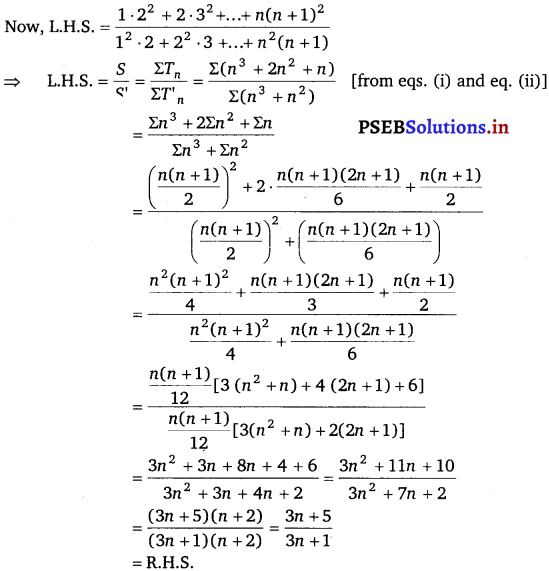
Hence Proved.
![]()
Question 27.
A farmer buys a used tractor for Rs. 12000. He pays Rs. 6000 cash and agrees to pay the balance in nnnual installments of Rs. 500 plus 12% interest on the unpaid amount. How much will be the tractor cost him?
Answer.
Total cost of the tractor = ₹ 12,000
Paid cost = ₹ 6,000
Balance = ₹ 6,000
No. of instalments @ ₹ 500 each = 12
Interest on first instalments = ₹ \(\left(\frac{6,000 \times 12 \times 1}{100}\right)\) = ₹ 720
First instalment = ₹ (500 + 720)
= ₹ 1220
Interest on second instalments = ₹ \(\left(\frac{5500 \times 12 \times 1}{100}\right)\) = ₹ 660
Second instalment = ₹ (500 + 660) = ₹ 1160
Third instalment = ₹ (500 + 600) = ₹ 1100 and so on
Total amount paid in instalments = ₹ (1220 + 1160 +1100 + ……………. to 12 terms)
Here, a = 1220,
d = 1160 – 1220 = – 60, n = 12
S = \(\frac{12}{2}\) [2 × 1220 + (12 – 1) (- 60)]
= 6 [2440 – 11 × 60]
= 6 [2440 – 660]
= 6 × 1780
= 10680 = ₹ 10680
Amount paid by farmer = ₹ (6000 +10680) = ₹ 16680.
Question 28.
Shamshad Ali buys a scooter for Rs. 22000. He pays Rs. 4000 cash and agrees to pay the balance in annual installment of Rs. 1000 plus 10% interest on the unpaid amount. How much will the scooter cost him?
Answer.
It is given that Shamshad Ali buys a scooter for Rs. 22000 and pays Rs. 4000 in cash.
∴ Unpaid amount = Rs. 22000 – Rs. 4000 = Rs. 18000
According to the given condition, the interest paid annually is 10% of 18000, 10% of 17000, 10% of 16000 … 10% of 1000
Thus, total interest to be paid
= 10% of 18000 + 10% of 17000 + 10% of 16000 + …………… + 10% of 1000
= 10% of (18000 + 17000 + 16000 + …………….. + 1000)
= 10% of (1000 + 2000 + 3000 + …………….. + 18000)
Here, 1000, 2000, 3000, ……………… 18000 forms an A.P. with first term and common difference both equal to 1000.
Let the number of terms be n.
∴ 18000 = 1000 + (n -1) (1000)
⇒ n = 18
∴ 1000 + 2000 + …. + 18000 = \(\frac{18}{2}\) [2(1000) + (18 – 1) (1000)]
= 9 [2000 + 17000] = 171000
∴ Total interest paid = 10% of (18000 + 17000 + 16000 + ………… + 1000)
= 10% of Rs. 171000
= Rs. 17100
∴ Cost of scooter = Rs. 22000 + Rs. 17100 = Rs. 39100.
![]()
Question 29.
A person writes a letter to four of his friends. He asks each one of them to copy the letter and mail to four different persons with instruction that they move the chain similarly. Assuming that the chain is not broken and that it costs 50 paise to mail one letter. Find the amount spent on the postage when 8th set of letter is mailed.
Answer.
The numbers of letters mailed forms a G.P. : 4, 42, ………….., 48
First term = 4,
Common ratio = 4,
Number of terms = 8
It is known that the sum of n terms of a GP. is given by Sn = \(\frac{a\left(r^{n}-1\right)}{r-1}\)
S8 = \(\frac{4\left(4^{8}-1\right)}{4-1}\)
= \(\frac{4(65536-1)}{3}=\frac{4(65535)}{3}\)
= 4(21845) = 87380
It is given that the cost to mail one letter is 50 paisa.
∴ Cost of mailing 87380 letters = Rs. 87380 × \(\frac{50}{100}\) = Rs. 43690
Thus, the amount spent when 8th set of letter is mailed is Rs. 43690.
Question 30.
A man deposited Rs. 10000 in a bank at the rate of 5% simple interest annually. Find the amount in 15th year since he deposited the amount and also calculate the total amount after 20 years.
Answer.
It is given that the man deposited Rs. 10000 in a bank at the rate of 5% simple interest annually.
∴ Interest in first year = \(\frac{5}{100}\) × Rs. 10000 = Rs. 500
Amount in 15th year = Rs. 10000 + 500 + 500 + ………. + 500 (14 times)
= Rs. 10000 + 14 × Rs. 500
= Rs. 10000 + Rs. 7000
= Rs. 17000
Amount after 20 years = Rs. 10000 + 500 + 500 + …………… + 500 (20 times)
= Rs. 10000 + 20 × Rs. 500
= Rs. 10000 + Rs. 10000
= Rs. 20000
Question 31.
A manufacturer reckons that the value of a machine, which costs him Rs. 15625, will depreciate each year by 20%. Find the estimated value at the end of 5 years.
Answer.
Cost of machine = Rs. 15625
Machine depreciates by 20% every year.
Therefore, its value after every year is 80% of the original cost i.e., \(\frac{4}{5}\) of the original cost.
∴ Value at the end of 5 years = 15625 × \(\frac{4}{5}\) × \(\frac{4}{5}\) × ……… × \(\frac{4}{5}\) (5 times)
= 5 × 1024 = 5120
Thus, the value of the machine at the end of 5 years is Rs. 5120.
Question 32.
150 workers were engaged to finish a job in a certain number of days. 4 workers dropped out on second day, 4 more workers dropped out on third day and so on. It took 8 more days to finish the work. Find the number of days in which the work was completed.
Answer.
Let x be the number of days in which 150 workers finish the work. According to the given information,
150x = 150 + 146 + 142 + …………… (x + 8) terms
The series 150 + 146 + 142 + ……………… (x + 8) terms is an A.P. with first term 150,
common difference = 4 and
number of terms as (x + 8).
⇒ 150x = \(\frac{x+8}{2}\) [2 (150) + (x + 8 – 1) (- 4)]
⇒ 150x = (x + 8) [150 + (x + 7) (- 2)]
⇒ 150x = (x + 8) (150 – 2x – 14)
⇒ 150x = (x + 8) (136 – 2x)
⇒ 75x = (x + 8) (68 – x)
⇒ 75x = 68x – x2 + 544 – 8x
⇒ x2 + 75x – 60x – 544 = 0
⇒ x2 + 15x – 544 = 0
⇒ x2 + 32x – 17x – 544 = 0
⇒ x(x + 32) – 17(x + 32) = 0
⇒ (x – 17) (x + 32) = 0
⇒ x = 17 or x = – 32
However, x cannot be negative.
∴ x = 17
Therefore, originally, the number of days in which the work was completed is 17.
Thus, required number of days = (17 + 8) = 25.
